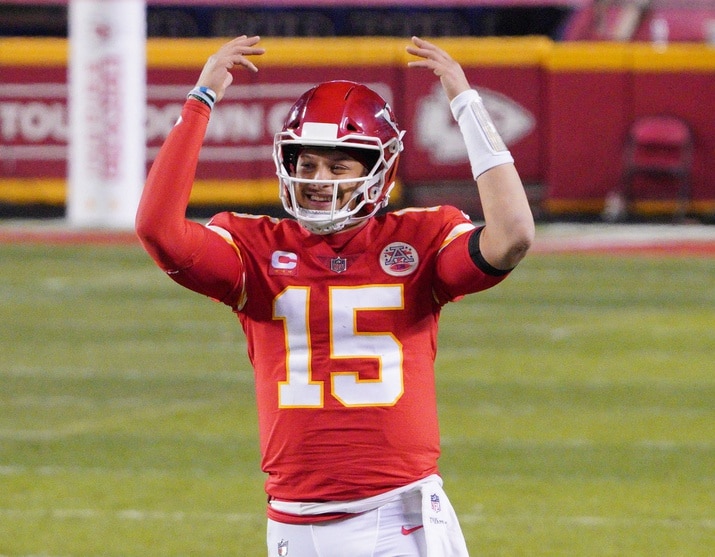Ad Disclosure
Opinion: Andy Reid, Kansas City Chiefs Gambled Patrick Mahomes’ Future and Won the Bet

It is dangerous and often misleading to judge decision-making based solely on outcome. Driving home after drinking five beers in two hours is a terrible idea. Completing the drive without hurting yourself or someone else doesn’t validate the choice.
In sports, though, winning tends to blot out every questionable decision or failure in execution that players and coaches are responsible for. Tom Brady played an objectively poor second half of the NFC Championship Game between the Tampa Bay Buccaneers and the Green Bay Packers on Sunday. Brady had a double-digit lead for most of the second half and, instead of nursing it and bleeding the clock, threw three interceptions. Green Bay would not have been in the game at the end but for Brady giving the ball away repeatedly.
Are you reading about that today? Of course not, because Brady’s team won the game despite his errors.
This brings us to the question of whether Andy Reid and the Kansas City Chiefs did the right thing in allowing former NFL Most Valuable Player Patrick Mahomes, their all-everything quarterback, to play in the AFC Championship Game on Sunday. The Chiefs won the game, 38-24, and advanced to the Super Bowl for the second consecutive season, so it must have been the correct decision, right?
Well, let’s look back a week:
Patrick Mahomes is in the locker room after being slow to get up on a run play.
(via @NFLBrasil) pic.twitter.com/1EmGx52HbC
— FOX Sports: NFL (@NFLonFOX) January 17, 2021
After taking an awkward hit in last week’s Divisional Round matchup with the Cleveland Browns, Mahomes looked like Conor McGregor a few seconds before Dustin Poirier turned his lights out Saturday night. From that moment on, there was laser focus on whether Mahomes would play a week after that hit. The first question that needed to be answered was whether Mahomes was actually concussed. We learned that answer during the game:
Patrick Mahomes officially out the remainder of the day with a concussion. Currently 22-17 KC with 11:07 left in the 4th.https://t.co/GXGMkUYs3u
— WFAN Sports Radio (@WFAN660) January 17, 2021
That diagnosis left the Chiefs in a real spot. Mahomes is 25 years old and currently signed to an astronomical long-term contract. How astronomical? As the ESPN report noted in July 2020:
The Chiefs and Super Bowl MVP quarterback Patrick Mahomes have reached agreement on a 10-year contract extension that ties him to Kansas City through the 2031 season, the team announced Monday.
League sources told ESPN’s Adam Schefter that the deal is worth $450 million over the 10-year period and could be worth up to $503 million. The extension includes a $140 million injury guarantee, as well as a no-trade clause.
We can all agree that every NFL player’s career or longevity is at risk with every snap. Still, Mahomes’ contract moved him into an entirely different risk classification. The Chiefs were willing to pay Mahomes so much, and to guarantee over $100 million even if he injured himself in a career-ending manner, because they projected him to be a truly unique asset, an irreplaceable talent.
Which makes the decision to, shall we say, fast-track his progress through the concussion protocol a little curious. Watch this timeline:
Patrick Mahomes set to practice, still not clear of concussion protocol https://t.co/EZyCW11wnm
— Newsweek (@Newsweek) January 20, 2021
Patrick Mahomes remains in the concussion protocol.
— Sam McDowell (@SamMcDowell11) January 21, 2021
Just walking off field at DEFCON 2. Chiefs QB Patrick Mahomes (concussion protocol, toe) observed during portion of Friday’s session open to media: stretching/conditioning and individual position drills. Third straight day he’s worked.
Reid talks at 1:15. Will know more soon. pic.twitter.com/JY8pgMZ0Tk
— Herbie Teope (@HerbieTeope) January 22, 2021
Patrick Mahomes is cleared to play Sunday in the AFC championship game. https://t.co/jgEx4xe1Tx
— Post Sports (@PostSports) January 22, 2021
I mean…it’s a miracle, I guess? No, because there is no such thing as a miracle, especially when it comes to traumatic brain injuries. Treating a concussion isn’t like treating a ligament strain or a viral infection, and it’s not the sort of thing that “just goes away.”
Because we know what decision was made, we really don’t need to waste time analyzing whether it was ultimately the player or the team that deliberately chose to have Mahomes take the field seven days after being unable to stand without falling without assistance. And we certainly don’t need to talk about whether the league ever thought about stepping in to protect the player…that just isn’t what the NFL does.
And if we’re being honest, it was never a serious consideration given the stakes. The skepticism and snark around the question of whether Mahomes would clear concussion protocol was pretty constant all week:
https://twitter.com/mybookiebet/status/1352328147895779329?s=20
Patrick Mahomes clearing concussion protocol this week pic.twitter.com/SHYz1u4YTo
— Athlete Tweets 🔥➐ (@AthleteTweetts) January 24, 2021
Hilarious.
So what have we learned? We learned that the NFL still doesn’t really care too much about whether its players, stars or not, take absurd and nearly unquantifiable risks with their futures even when they are already compromised. We learned that, if the game is big enough, a team will look much harder for the justification to get a player back on the field than it will ever err on the side of safety. And we learned that players want to play in those big games, because that’s really the reason they do the job in the first place. Long-term health is tomorrow’s problem.
In other words, as usually happens in these situations, we really learned nothing new at all.
Formerly a Featured Columnist on the Philadelphia Phillies and Manchester City Football Club for Bleacher Report. Full-time attorney, part-time pundit. Follow me @philkeidel on Twitter.